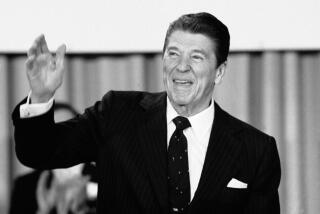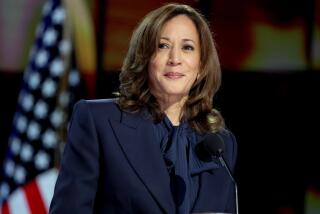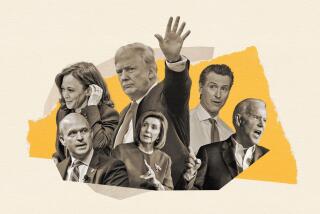NEWS ANALYSIS : Liberals Fear Further Loss of Political Clout
WASHINGTON — Liberalism, which energized Democratic policy-makers from Franklin D. Roosevelt’s New Deal to Lyndon B. Johnson’s Great Society, is struggling against the tide in Bill Clinton’s Washington.
After 12 years of frustration under Republican rule, liberals toiled on behalf of candidate Clinton, hoping his election would spark a comeback for them and their ideals.
But now, longtime liberal activists fear that President Clinton’s New Democratic agenda, with its emphasis on catering to the middle class, in contrast to their faith--using government to aid the disadvantaged--could consign American liberalism to the dustbin of history.
All that liberals are likely to get under Clinton, in the view of many analysts, is leftover benefits from middle-class programs, or what amounts to “trickle-down” liberalism.
To add to their woes, liberals believe they have become convenient scapegoats for the President’s public perception problems.
“I think right now we are getting the worst of both worlds,” complains Steve Cobble, who was field director for Jesse Jackson’s 1988 presidential campaign and is now a political consultant based in Grinnell, Iowa. “Not only are we not getting the policies we want, but the conventional wisdom is that the reason Clinton is in trouble is that he’s too liberal.”
For example, in the congressional debate over Clinton’s budget proposals, Cobble noted, Republicans are castigating Clinton as a tax-and-spend liberal in moderate’s clothing.
“But the main reason he’s raising taxes is to reduce the deficit, not to fund some massive investment program. It’s a Perot reason, not a liberal reason,” Cobble complained recently, referring to former independent presidential candidate Ross Perot.
Clinton himself is as much a symptom as a cause of the liberal predicament. Liberals themselves acknowledge that their loss of clout is rooted in fundamental demographic and structural changes. Foremost among them are the erosion of the nation’s urban centers and trade unions, which formed much of the liberal power base.
Also important is the growing apathy among low-income voters, who once helped provide liberal majorities.
“As a powerful political movement packing a lot of votes and prepared to help somebody they like and punish somebody they don’t like, I don’t think there is any real ‘left’ out there anymore,” says Austin Ranney, a political scientist at UC Berkeley.
Another formidable obstacle to liberal recovery is the huge federal deficit left over from the Republican years. The nation’s economic doldrums turn any attempt to establish priorities for government spending into a zero-sum game, in which money for new programs must come from cutting old ones or by raising taxes. It is a liberal dilemma that delights right-wingers.
“Clinton would be more liberal if the country could afford it,” contends Brent Bozell, head of the Conservative Victory Fund, which contributes to conservative office seekers. “The biggest complaint people have against liberal programs is not that they don’t have any value, but they don’t see how we can pay for it.”
Compounding their problems is growing middle-class resistance to tax increases, says Kevin Phillips, a former campaign strategist for President Richard Nixon and now a leading interpreter of what he calls middle-class populism.
“To the extent that you tell the middle class you are going to tax the rich so you can give more to the middle class, they will love you,” Phillips says. “But if you tell suburbia you are going to tax them more so you can give more to low-income school districts, they are not going to do it.”
Some observers believed that liberals would be aided by the collapse of the Soviet Union and the end of the immediate threat of Communist aggression--a development that robbed conservatives of one of their major issues.
But, Ranney noted, internal divisions and conflicts among liberals kept them from taking advantage of communism’s demise.
The in-house rivalries have turned segments of the old liberal coalition against each other in even more fierce competition for the now meager rewards government can provide.
This sort of conflict was exemplified by the opposition of Jewish groups, until recent years among the foremost backers of civil rights, to Clinton’s abortive nomination of C. Lani Guinier to head the Justice Department’s civil rights division. To some Jews, Guinier’s aggressive advocacy of extending the voting rights of minorities smacked of quotas, and they joined with conservatives in opposing her nomination.
“There are issues where blacks and Jews are very different, and maybe the two will never meet,” says Rep. Maxine Waters (D-Los Angeles), who is black. “They have made very clear that they are opposed to affirmative action, and we are very pro-affirmative action. And we’ve never been able to resolve that.
Still, some liberals have not given up hope. “We now have the politics of possibility,” claims Democratic Sen. Paul Wellstone of Minnesota, who just completed a two-year term as president of Americans for Democratic Action, one of the country’s oldest strongholds of traditional liberalism. “There is more room for us to push hard on health care, jobs and education.”
And liberals applaud Clinton’s proposal for promoting national service, which offers young people, from both middle- and low-income groups, a chance to work off their college loans. But consultant Cobble worries that the program, now moving through Congress, will not be backed by enough money to have any real impact or even to “make the point that government can actually do something.”
At any rate, liberal hopes for incremental progress under Clinton are a far cry from the vistas that loomed before them under past Democratic presidents.
In his second inaugural address in 1937, Franklin Roosevelt called upon a citizenry still recovering from the Great Depression to remedy the plight of “one-third of a nation, ill-housed, ill-clad, ill-nourished.”
Said F.D.R.: “The state of our progress is not whether we add more to the abundance of those who have much, it is whether we provide enough for those who have too little.”
In a similar vein, in 1964, President Johnson declared “an unconditional war on poverty in America,” targeted to aid “that one-fifth of all American families with incomes too small to even meet their basic needs.”
Even under the next Democratic President, Jimmy Carter, liberals, already in decline, rallied behind the candidacy of Sen. Edward M. Kennedy (D-Mass.), forcing Carter to make part of the party’s 1980 platform a clutch of activist economic nostrums, including a multibillion-dollar jobs program.
In stark contrast, nowadays liberals must come to terms with the centrist themes of Clinton’s rhetoric, which appeal unabashedly to what Clinton often referred to as “the forgotten middle class.
“Putting our people first means honoring and rewarding those who work hard and play by the rules,” Clinton declared during the campaign as he outlined the economic strategy he would pursue as President. “ . . . It means that we must reward work, demand responsibility and end welfare as we know it.”
Rather than keeping the promise of equal results implied by traditional liberalism, Clinton stressed equal opportunity; instead of pledging to expand aid for the poor, he vowed to make longtime welfare recipients take jobs or lose their benefits.
“Above all, Clinton’s policies are rooted in the values of the middle class,” says Stanley B. Greenberg, Clinton pollster and strategist. “What is old and failed about liberalism is the idea of targeting programs and initiatives which seek to narrowly benefit particular groups, the bottom half of the ladder.”
What this translates into is “a trickle-down version of liberalism,” says analyst Kevin Phillips.
“The middle class wants some kind of national health insurance,” he explains, “and as part of getting it they realize poor people have to be covered too. But what you have to realize is that middle-class populism gives you trickle-down for the poor. It doesn’t give you the flat-out activism liberals want.”
Clinton’s stress on the middle class troubles some liberals who view it as potentially divisive.
“I do believe there are ways to talk about fairness and equity without polarizing people,” Waters says. And she complains that Clinton’s campaign pitch at the middle class was in part “an attempt to send a message that I thought was detrimental to the whole notion of people feeling concern for each other.”
Nevertheless, Waters came out early for Clinton, hoping, like other liberals, to be able to exert influence on his policies as President.
“I decided to support him anyway, so that I and others--despite the fact that we are left-leaning--would have our foot in the door . . . . Now we have got a foot in the door, and we need to rail against policies that are too far to the right.”
Some believe that if liberalism is to survive at all in the Clinton era, its champions must dig in their heels and resort to new strategies. “We can’t shrink from engaging the President because he is a Democrat,” says another black lawmaker, Rep. Craig Washington (D-Tex.).
Hard-line tactics can pay off, as was demonstrated during the recent budget battle in the Senate, where a handful of liberals forced a scaling back of proposed Medicare cuts by threatening to oppose the legislation.
Beyond this, liberals are exploring some changes in approach to deal with the era of middle-class politics. One idea is to pay less attention to Washington, where the budget deficit poses a huge obstacle, and more to dealing with everyday problems at the grass roots, through community action.
“Perot was right about one thing, the two major parties are decomposing,” said Dan Cantor, one of the leaders of the New Party, which has set up 10 chapters in cities around the country.
The New Party, says Cantor, seeks to build support by combining traditional appeals--like those associated with the labor movement--with new social movements, such as environmentalism and family rights.
Another new approach, put forward by Michael Lerner, editor of the progressive magazine Tikkun, is for liberals to widen their scope, reaching beyond their traditional focus on economic issues to confront more personal and emotional problems, such as what he calls “the crisis in family life, the crisis in ethics, the crisis in the world of work.”
But some analysts believe the chances for a genuine liberal revival depend on events, most particularly on an economic slump worse than the 1991 recession.
“Maybe what you need is 1932 all over again,” said University of Texas political scientist Walter Dean Burnham, referring to the economic disaster that helped forge modern American liberalism.
And if the economy does slump again, or fails to make much of a recovery, some liberals believe the current differences they have with Clinton will boost their stock among disgruntled citizens.
“At some point, we don’t think his programs will be substantial enough to make the changes he is talking about,” said Leon Shull, who was national director of Americans for Democratic Action for 20 years until his retirement in 1984. “And that’s when people will remember that liberals said exactly that.”
More to Read
Sign up for Essential California
The most important California stories and recommendations in your inbox every morning.
You may occasionally receive promotional content from the Los Angeles Times.










